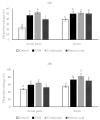Cordycepin Isolated from Cordyceps militaris: Its Newly Discovered Herbicidal Property and Potential Plant-Based Novel Alternative to Glyphosate
- PMID: 31405038
- PMCID: PMC6720702
- DOI: 10.3390/molecules24162901
Cordycepin Isolated from Cordyceps militaris: Its Newly Discovered Herbicidal Property and Potential Plant-Based Novel Alternative to Glyphosate
Abstract
There is currently much interest in finding new phytochemicals among plants and fungi as nature-based alternatives to replace problematic herbicides such as glyphosate, which are preferentially used in agricultural production n. We discovered striking herbicidal potency in Cordyceps militaris (L.) and identified cordycepin as its principal plant growth inhibitor. Cordycepin obtained as an ethyl acetate extract was subjected to column chromatography and evaluated for its bioassay-guided phytotoxic capacity against Raphanus sativus (radish), showing a maximum inhibition on germination and growth of radish (IC50 = 0.052-0.078 mg/mL). Gas chromatography-mass spectrometry (GC-MS) (m/z: 251.2) and liquid chromatography-electrospray ionization-mass spectrometry (LC-ESI-MS) ([M + Na]+ m/z: 274.1; [M + H]+ m/z: 252.1) analyses confirmed cordycepin as the major component of the tested column fraction (55.38%). At 0.04 mg/mL, cordycepin showed 3.8-5.9- and 3.3-3.7-fold greater inhibition of the germination and growth of radish than benzoic acid (BA) and glyphosate, respectively. Compared with BA, isolated cordycepin reduced plant chlorophyll and carotenoid contents (2.0-9.5 -fold), while proline, total phenolic and total flavonoid contents were increased 1.2-1.8-fold. Finally, cordycepin promoted electrolyte leakage and malondialdehyde accumulation in radish aerial parts. Thus, cordycepin successfully isolated from Cordyceps militaris is a highly potent plant growth inhibitor with pending worldwide patent and may become a potential plant-based novel alternative to the disputed glyphosate.
Keywords: Cordyceps militaris; Raphanus sativus; allelochemical; allelopathy; column chromatography; cordycepin; germination; glyphosate; growth; inhibition; plant growth inhibitor.
Conflict of interest statement
The authors declare no conflict of interest.
Figures










References
-
- Xuan T.D., Tawata S., Khanh T.D., Chung I.M. Decomposition of Allelopathic Plants in Soil. J. Agron. Crop. Sci. 2005;191:162–171. doi: 10.1111/j.1439-037X.2005.00170.x. - DOI
-
- Trezzi M.M., Vidal R.A., Junior A.A.B., Bittencourt H.V.H., Filho A.P.D.S.S. Allelopathy: Driving mechanisms governing its activity in agriculture. J. Plant Interact. 2016;11:53–60. doi: 10.1080/17429145.2016.1159342. - DOI
-
- Ladhari A., Omezzine F., Haouala R. The impact of Tunisian Capparidaceae species on cytological, physiological and biochemical mechanisms in lettuce. S. Afr. J. Bot. 2014;93:222–230. doi: 10.1016/j.sajb.2014.04.014. - DOI
-
- Omezzine F., Ladhari A., Haouala R. Physiological and biochemical mechanisms of allelochemicals in aqueous extracts of diploid and mixoploid Trigonella foenum-graecum L. S. Afr. J. Bot. 2014;93:167–178. doi: 10.1016/j.sajb.2014.04.009. - DOI
-
- Osivand A., Araya H., Appiah K.S., Mardani H., Ishizaki T., Fujii Y. Allelopathy of Wild Mushrooms—An Important Factor for Assessing Forest Ecosystems in Japan. Forests. 2018;9:773. doi: 10.3390/f9120773. - DOI
MeSH terms
Substances
LinkOut - more resources
Full Text Sources
Miscellaneous

